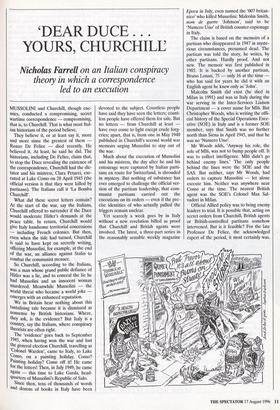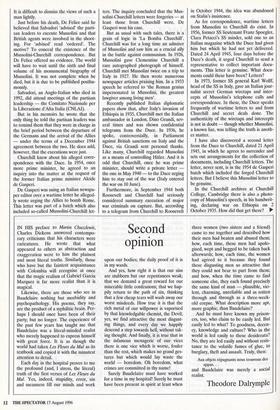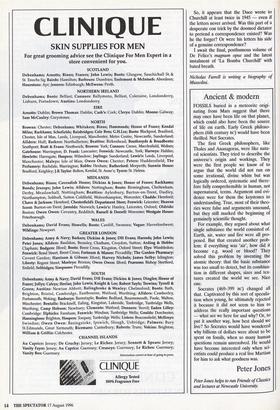`DEAR DUCE . . .
YOURS, CHURCHILL
Nicholas Farrell on an Italian conspiracy theory in which a correspondence led to an execution
MUSSOLINI and Churchill, though ene- mies, conducted a compromising, secret wartime correspondence — compromising, that is, to Churchill. That is what most Ital- ian historians of the period believe.
They believe it, or at least say it, more and more since the greatest of them — Renzo De Felice — died recently. He believed it. At least, he said he did. The historians, including De Felice, claim that, to stop the Duce revealing the existence of the correspondence, Churchill had the dic- tator and his mistress, Clara Petacci, exe- cuted at Lake Como on 28 April 1945 (the official version is that they were killed by Partisans). The Italians call it `La Bomba Churchill'.
What did these secret letters contain? At the start of the war, say the Italians, Churchill offered to surrender if the D.uce would moderate Hitler's demands at the peace table. In return, Churchill would give Italy handsome territorial concessions — including French colonies. But then, even when the tide had turned, Churchill is said to have kept on secretly writing, Offering Mussolini, for example, at the end of the war, an alliance against Stalin to combat the communist menace.
So Churchill, according to the Italians, was a man whose grand public defiance of Hitler was a lie, and to conceal the lie he had Mussolini and an innocent woman murdered. Meanwhile Mussolini — the world threat who became a world joke emerges with an enhanced reputation.
We in Britain hear nothing about this tantalising tale because it is dismissed as nonsense by British historians. Where, they ask, is the evidence? But Italy is a country, say the Italians, where conspiracy theorists are often right. The 'evidence' goes back to September 1945, when having won the war and lost the general election Churchill, travelling as Colonel Warden', came to Italy, to Lake Como, on a painting holiday. Como? Painting holiday? Come off it! He came for the letters! Then, in July 1949, he came again — this time to Lake Garda, head- quarters of Mussolini's Republic of Salo. Since then, tens of thousands of words and dozens of books in Italy have been devoted to the subject. Countless people have said they have seen the letters; count- less people have offered them for sale. But no letters — from Churchill at least have ever come to light except crude forg- eries; apart, that is, from one in May 1940 published in Churchill's second world war memoirs urging Mussolini to stay out of the war.
Much about the execution of Mussolini and his mistress, the day after he and his entourage were captured by Italian parti- sans en route for Switzerland, is shrouded in mystery. But nothing of substance has ever emerged to challenge the official ver- sion of the partisan leadership, that com- munist partisans carried out the executions on its orders — even if the pre- cise identities of who actually pulled the triggers remain unclear.
Yet scarcely a week goes by in Italy without a new revelation billed as proof that Churchill and British agents were involved. The latest, a three-part series in the reasonably sensible weekly magazine Epoca in July, even named the '007 britan- nico' who killed Mussolini: Malcolm Smith, nom de guerre 'Johnson', said to be `Numero Uno' of British counter-espionage in Italy.
The claim is based on the memoirs of a partisan who disappeared in 1947 in myste- rious circumstances, presumed dead. The partisan was told the story, he writes, by other partisans. Hardly proof. And not new. The memoir was first published in 1985. It is backed by another partisan, Bruno Lonati, 75 — only 16 at the time who has said for years he did it with an English agent he knew only ai`John'.
Malcolm Smith did exist (he died in Milan in 1991) and was in Italy during the war serving in the Inter-Services Liaison Department — a cover name for MI6. But Christopher Woods, who is writing the offi- cial history of the Special Operations Exec- utive (SOE) in Italy and is a former SOE member, says that Smith was no further north than Siena in April 1945, and that he was no 'Numero Uno'.
Mr Woods adds, 'Anyway his role, the role of MI6, was not to bump people off. It was to collect intelligence. MI6 didn't go behind enemy lines.' The only people behind the lines were the SOE and the SAS. But neither, says Mr Woods, had orders to capture Mussolini — let alone execute him. Neither was anywhere near Como at the time. The nearest British agent was the SOE's Colonel Max Sal- vadori in Milan.
Official Allied policy was to bring enemy leaders to trial. It is possible that, acting on secret orders from Churchill, British agents or British-controlled partisans somehow intervened. But is it feasible? For the late Professor De Felice, the acknowledged expert of the period, it most certainly was. It is difficult to dismiss the views of such a man lightly.
Just before his death, De Felice said he believed that Salvadori 'advised' the parti- san leaders to execute Mussolini and that British agents were involved in the shoot- ing. For 'advised' read 'ordered'. The motive? To conceal the existence of the Mussolini-Churchill correspondence. But De Felice offered no evidence. The world will have to wait until the sixth and final volume of his monumental biography of Mussolini. It was not complete when he died, but it is due to be published posthu- mously.
Salvadori, an Anglo-Italian who died in 1992, did attend meetings of the partisan leadership — the Comitato Nazionale per la Liberazione d'Alta Italia (CNLAI).
But in his memoirs he wrote that the only thing he told the partisan leaders was to remind them that they were in charge in the brief period between the departure of the Germans and the arrival of the Allies — under the terms of a December 1944 agreement between the two. He does add, however, that the executions were just.
Churchill knew about his alleged corre- spondence with the Duce. In 1954, once more prime minister, he agreed to an inquiry into the matter at the request of the former Italian prime minister Alcide de Gasperi.
De Gasperi was suing an Italian newspa- per editor over a wartime letter he alleged- ly wrote urging the Allies to bomb Rome. This letter was part of a batch which also included so-called Mussolini-Churchill let-
ters. The inquiry concluded that the Mus- solini-Churchill letters were forgeries — at least those from Churchill were. De Gasperi won his case.
But as usual with such tales, there is a grain of logic in 'La Bomba Churchill'. Churchill was for a long time an admirer of Mussolini and saw him as a crucial ally in the battle against communism. In 1926, Mussolini gave Clementine Churchill a rare autographed photograph of himself. Churchill met Mussolini twice on a trip to Italy in 1927. He then wrote numerous newspaper articles praising him. In a 1933 speech he referred to 'the Roman genius impersonated in Mussolini, the greatest lawgiver among living men'.
Recently published Italian diplomatic papers show that, after Italy's invasion of Ethiopia in 1935, Churchill met the Italian ambassador in London, Dino Grandi, sev- eral times and was shown confidential telegrams from the Duce. In 1936, he spoke, controversially, in Parliament against British sanctions on Italy and the Duce, via Grandi sent personal thanks. Like many, Churchill regarded Mussolini as a means of controlling Hitler. And it is odd that Churchill, once he was prime minister, should write a private letter the one in May 1940 — to the Duce urging him to stay out of the war (Italy entered the war on 10 June).
Furthermore, in September 1944 both Roosevelt and Churchill had seriously considered summary execution of major war criminals on capture. But, according to a telegram from Churchill to Roosevelt in October 1944, the idea was abandoned on Stalin's insistence.
As for correspondence, wartime letters from Mussolini to Churchill do exist. In 1956, former SS lieutenant Franz Spoegler, Clara Petacci's SS minder, sold one to an Italian magazine which the Duce had given him but which he had not yet delivered. Dated 24 April 1945, four days before the Duce's death, it urged Churchill to send a representative to collect important docu- ments. This letter is genuine. What docu- ments could these have been? Letters?
In 1973, former SS general Karl Wolff, head of the SS in Italy, gave an Italian jour- nalist secret German wiretaps and inter- cepts of Mussolini's telephone calls and correspondence. In these, the Duce speaks frequently of wartime letters to and from Churchill and secret deals done. The authenticity of the wiretaps and intercepts is not in doubt — though whether Mussolini, a known liar, was telling the truth is anoth- er matter.
I have also discovered a second letter from the Duce to Churchill, dated 21 April 1945, in which he agrees to surrender and sets out arrangements for the collection of documents, including Churchill letters. The letter, never sent, is in the 1954 de Gasperi batch which included the forged Churchill letters. But I believe this Mussolini letter to be genuine.
In the Churchill archives at Churchill College, Cambridge there is also a photo- copy of Mussolini's speech, in his handwrit- ing, declaring war on Ethiopia on 2 October 1935. How did that get there? 10'
So, it appears that the Duce wrote to Churchill at least twice in 1945 — even if the letters never arrived. Was this part of a desperate con trick by the doomed dictator to pretend a correspondence existed? Was he the forger? Or were his letters his side of a genuine correspondence?
I await the final, posthumous volume of De Felice's magnum opus and the latest instalment of 'La Bomba Churchill' with bated breath.
Nicholas Farrell is writing a biography of Mussolini.




















































 Previous page
Previous page